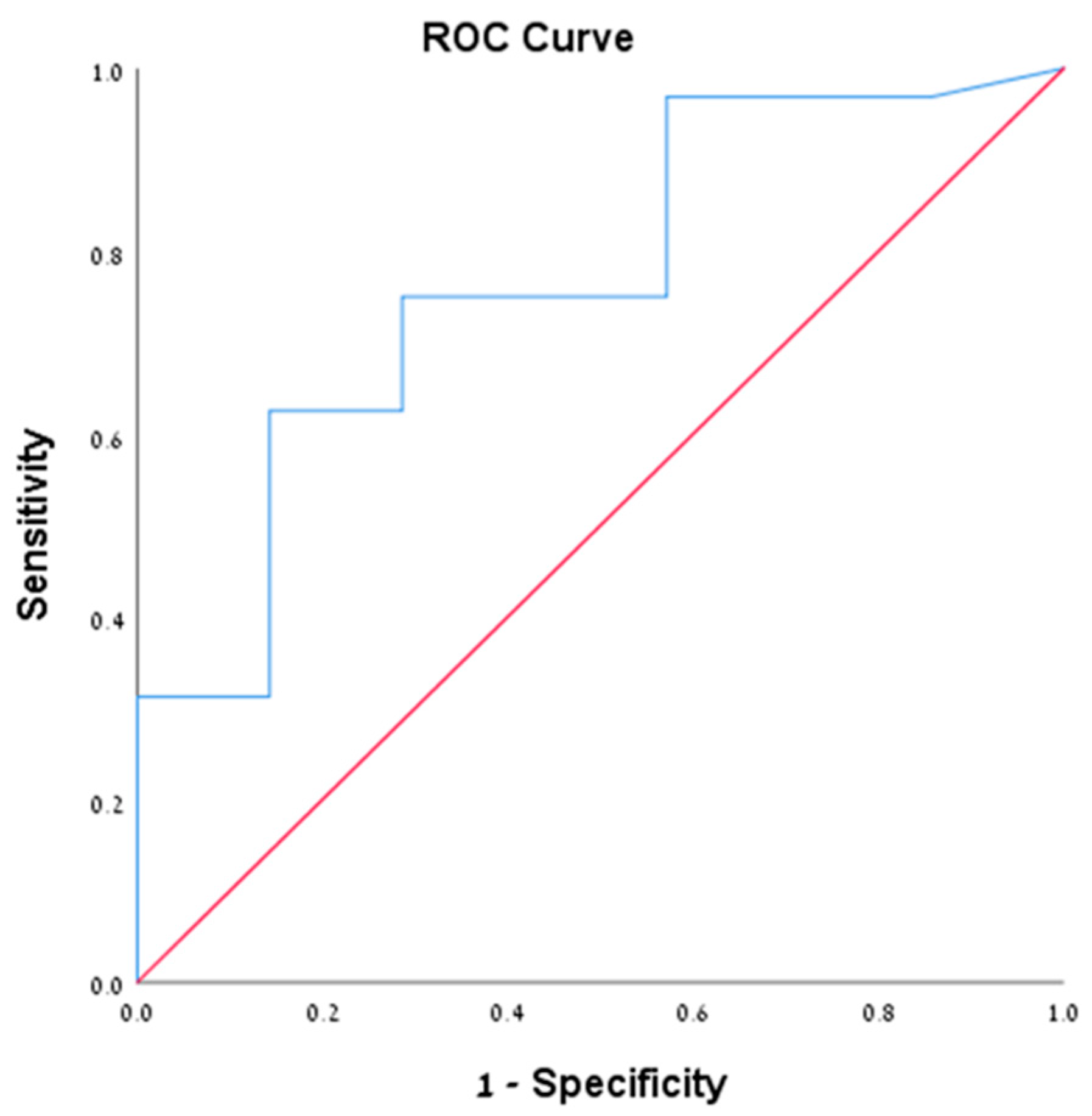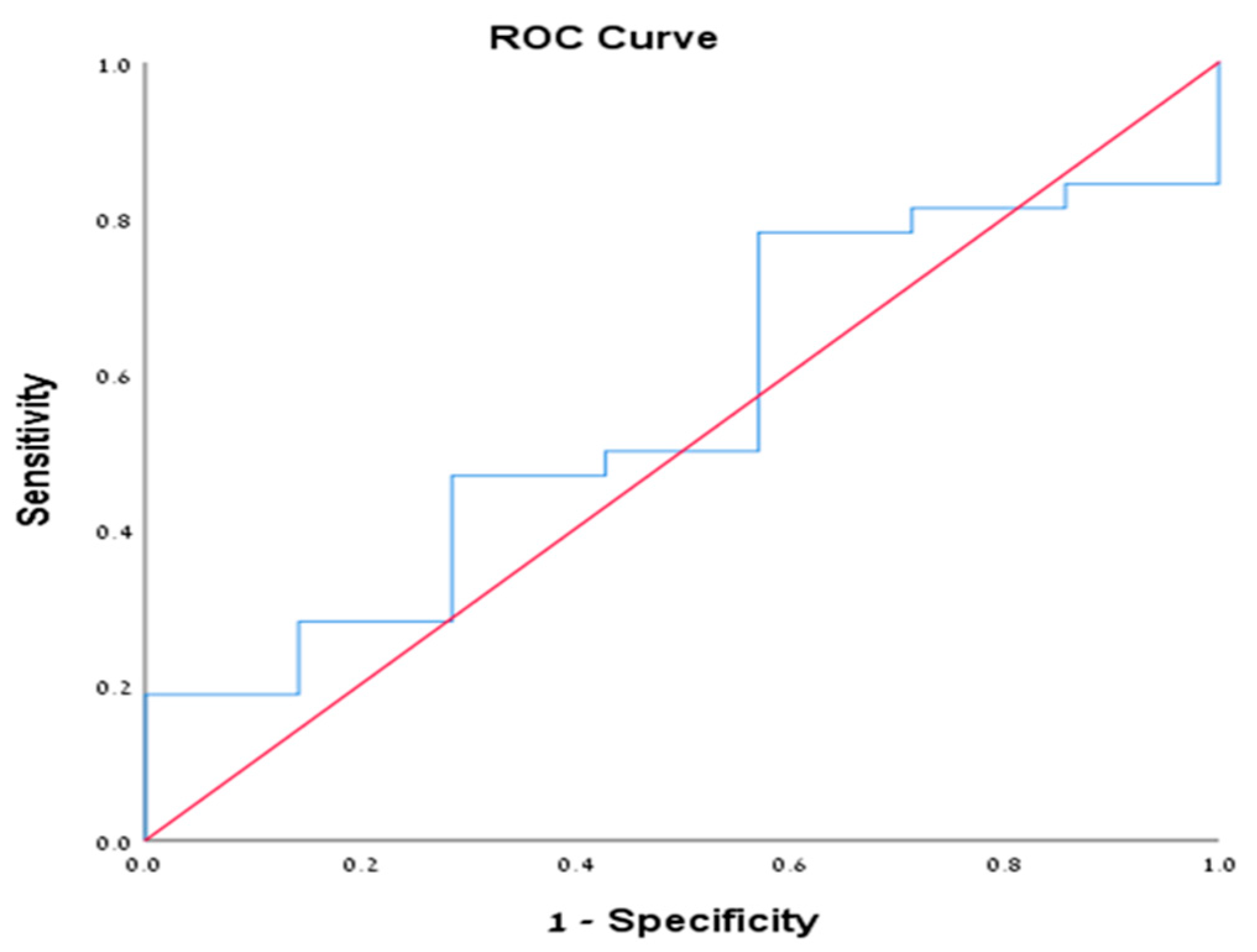The Utility of Endoscopic Ultrasound Fine Needle Aspiration in Pancreatic Cystic Lesions Diagnosis
Abstract
1. Introduction
2. Methods
2.1. Morphologic Sonographic Characterization of Pancreatic Cyst
2.2. Chemical Diagnosis
2.3. Cytological Diagnosis
2.4. Statistical Analysis
3. Results
3.1. Demographics, Chemical and Morphologic Sonographic Characteristics
3.2. Agreement between Endoscopic Ultrasonographic Diagnosis of Mucinous Cysts (IPMN and MCN) with Cyst CEA Level
3.3. Correlation between Morphologic Ultrasonographic Diagnosis of SCA and Chemical Analysis (Amylase and CEA)
3.4. Subgroup Analysis of Positive Cytology Group
4. Discussion
Author Contributions
Funding
Conflicts of Interest
Abbreviations
References
- De Jong, K.; Nio, C.Y.; Mearadji, B.; Phoa, S.S.; Engelbrecht, M.R.; Dijkgraaf, M.G.; Bruno, M.J.; Fockens, P. Disappointing Interobserver Agreement among Radiologists for a Classifying Diagnosis of Pancreatic Cysts Using Magnetic Resonance Imaging. Pancreas 2012, 41, 278–282. [Google Scholar] [CrossRef] [PubMed]
- Laffan, T.A.; Horton, K.M.; Klein, A.P.; Berlanstein, B.; Siegelman, S.S.; Kawamoto, S.; Johnson, P.T.; Fishman, E.K.; Hruban, R.H. Prevalence of unsuspected pancreatic cysts on MDCT. Am. J. Roentgenol. 2008, 191, 802–807. [Google Scholar] [CrossRef] [PubMed]
- Castillo, C.F.-D.; Targarona, J.; Thayer, S.P.; Rattner, D.W.; Brugge, W.R.; Warshaw, A.L. Incidental Pancreatic Cysts. Arch. Surg. 2003, 138, 427–434. [Google Scholar] [CrossRef] [PubMed]
- Valsangkar, N.P.; Morales-Oyarvide, V.; Thayer, S.P.; Ferrone, C.R.; Wargo, J.A.; Warshaw, A.L.; Castillo, C.F.-D. 851 resected cystic tumors of the pancreas: A 33-year experience at the Massachusetts General Hospital. Surgery 2012, 152, S4–S12. [Google Scholar] [CrossRef] [PubMed]
- Oh, H.-C.; Kim, M.-H.; Hwang, C.Y.; Lee, T.Y.; Lee, S.S.; Seo, D.-W.; Lee, S.K. Cystic Lesions of the Pancreas: Challenging Issues in Clinical Practice. Am. J. Gastroenterol. 2008, 103, 229–239. [Google Scholar] [CrossRef] [PubMed]
- Wang, Q.-X.; Xiao, J.; Orange, M.; Zhang, H.; Zhu, Y.-Q. EUS-Guided FNA for Diagnosis of Pancreatic Cystic Lesions: A Meta-Analysis. Cell. Physiol. Biochem. 2015, 36, 1197–1209. [Google Scholar] [CrossRef]
- Khashab, M.A.; Kim, K.; Lennon, A.M.; Shin, E.J.; Tignor, A.S.; Amateau, S.K.; Singh, V.K.; Wolfgang, C.L.; Hruban, R.H.; Canto, M.I. Should We Do EUS/FNA on Patients with Pancreatic Cysts? The Incremental Diagnostic Yield of EUS over CT/MRI for Prediction of Cystic Neoplasms. Pancreas 2013, 42, 717–721. [Google Scholar] [CrossRef]
- Thornton, G.; McPhail, M.; Nayagam, S.; Hewitt, M.; Vlavianos, P.; Monahan, K.J. Endoscopic ultrasound guided fine needle aspiration for the diagnosis of pancreatic cystic neoplasms: A meta-analysis. Pancreatology 2013, 13, 48–57. [Google Scholar] [CrossRef]
- Das, A.; Ngamruengphong, S.; Nagendra, S.; Chak, A. Asymptomatic pancreatic cystic neoplasm: A cost-effectiveness analysis of different strategies of management. Gastrointest. Endosc. 2009, 70, 690–699. [Google Scholar] [CrossRef] [PubMed]
- Brugge, W.R. Diagnosis and management of cystic lesions of the pancreas. J. Gastrointest. Oncol. 2015, 6, 375–388. [Google Scholar]
- Kubo, H.; Nakamura, K.; Itaba, S.; Yoshinaga, S.; Kinukawa, N.; Sadamoto, Y.; Ito, T.; Yonemasu, H.; Takayanagi, R. Differential diagnosis of cystic tumors of the pancreas by endoscopic ultrasonography. Endoscopy 2009, 41, 684–689. [Google Scholar] [CrossRef] [PubMed]
- Muthusamy, V.R.; Chandrasekhara, V.; Acosta, R.D.; Bruining, D.H.; Chathadi, K.V.; Eloubeidi, M.A.; Faulx, A.L.; Fonkalsrud, L.; Gurudu, S.R.; Khashab, M.A.; et al. The role of endoscopy in the diagnosis and treatment of cystic pancreatic neoplasms. Gastrointest. Endosc. 2016, 84, 1–9. [Google Scholar] [CrossRef]
- Frossard, J.L.; Amouyal, P.; Amouyal, G.; Palazzo, L.; Amaris, J.; Soldan, M.; Giostra, E.; Spahr, L.; Hadengue, A.; Fabre, M. Performance of endosonography-guided fine needle aspiration and biopsy in the diagnosis of pancreatic cystic lesions. Am. J. Gastroenterol. 2003, 98, 1516–1524. [Google Scholar] [CrossRef] [PubMed]
- Brugge, W.R.; Lewandrowski, K.; Lee-Lewandrowski, E.; Centeno, B.A.; Szydlo, T.; Regan, S.; Del Castillo, C.F.; Warshaw, A.L. Diagnosis of pancreatic cystic neoplasms: A report of the cooperative pancreatic cyst study. Gastroenterology 2004, 126, 1330–1336. [Google Scholar] [CrossRef] [PubMed]
- Van Der Waaij, L.A.; Van Dullemen, H.M.; Porte, R.J. Cyst fluid analysis in the differential diagnosis of pancreatic cystic lesions: A pooled analysis. Gastrointest. Endosc. 2005, 62, 383–389. [Google Scholar] [CrossRef]
- European Study Group on Cystic Tumours of the Pancreas. European evidence-based guidelines on pancreatic cystic neoplasms. Gut 2018, 67, 789–804. [Google Scholar] [CrossRef]
- Snozek, C.L.; Mascarenhas, R.C.; O’Kane, D.J. Use of cyst fluid CEA, CA19-9, and amylase for evaluation of pancreatic lesions. Clin. Biochem. 2009, 42, 1585–1588. [Google Scholar] [CrossRef]
- Khalid, A.; Zahid, M.; Finkelstein, S.D.; Leblanc, J.K.; Kaushik, N.; Ahmad, N.; Brugge, W.R.; Edmundowicz, S.; Hawes, R.H.; McGrath, K.M. Pancreatic cyst fluid DNA analysis in evaluating pancreatic cysts: A report of the PANDA study. Gastrointest. Endosc. 2009, 69, 1095–1102. [Google Scholar] [CrossRef]
- Leung, K.K.; Ross, W.A.; Evans, D.; Fleming, J.; Lin, E.; Tamm, E.P.; Lee, J.H. Pancreatic Cystic Neoplasm: The Role of Cyst Morphology, Cyst Fluid Analysis, and Expectant Management. Ann. Surg. Oncol. 2009, 16, 2818–2824. [Google Scholar] [CrossRef]
- Linder, J.D.; Geenen, J.E.; Catalano, M.F. Cyst fluid analysis obtained by EUS-guided FNA in the evaluation of discrete cystic neoplasms of the pancreas: A prospective single-center experience. Gastrointest. Endosc. 2006, 64, 697–702. [Google Scholar] [CrossRef]
- O’Toole, D.; Palazzo, L.; Hammel, P.; Ben Yaghlene, L.; Couvelard, A.; Felce-Dachez, M.; Fabre, M.; Dancour, A.; Aubert, A.; Sauvanet, A.; et al. Macrocystic pancreatic cystadenoma: The role of EUS and cyst fluid analysis in distinguishing mucinous and serous lesions. Gastrointest. Endosc. 2004, 59, 823–829. [Google Scholar] [CrossRef]
- Ryu, J.K.; Woo, S.M.; Hwang, J.-H.; Jeong, J.B.; Yoon, Y.B.; Park, I.A.; Han, J.K.; Kim, Y.-T. Cyst fluid analysis for the differential diagnosis of pancreatic cysts. Diagn. Cytopathol. 2004, 31, 100–105. [Google Scholar] [CrossRef] [PubMed]
- Dumonceau, J.-M.; Deprez, P.H.; Jenssen, C.; Garcia, D.D.L.I.; Larghi, A.; Vanbiervliet, G.; Aithal, G.P.; Arcidiacono, P.G.; Bastos, P.; Carrara, S.; et al. Indications, results, and clinical impact of endoscopic ultrasound (EUS)-guided sampling in gastroenterology: European Society of Gastrointestinal Endoscopy (ESGE) Clinical Guideline—Updated January 2017. Endoscopy 2017, 49, 695–714. [Google Scholar] [CrossRef] [PubMed]
- Thosani, N.; Thosani, S.; Qiao, W.; Fleming, J.B.; Bhutani, M.S.; Guha, S. Role of EUS-FNA-based cytology in the diagnosis of mucinous pancreatic cystic lesions: A systematic review and meta-analysis. Dig. Dis. Sci. 2010, 55, 2756–2766. [Google Scholar] [CrossRef]
- Aparicio, J.R.; Martinez, J.; Niveiro, M.; Cabezas, A.; Ruiz, F.; De-Madaria, E.; Casellas, J.A. Direct intracystic biopsy and pancreatic cystoscopy through a 19-gauge needle EUS (with videos). Gastrointest. Endosc. 2010, 72, 1285–1288. [Google Scholar] [CrossRef]
- Antillon, M.R.; Tiwari, P.; Bartalos, C.R.; Marshall, J.B. Taking SpyGlass outside the GI tract lumen in conjunction with EUS to assist in the diagnosis of a pancreatic cystic lesion (with video). Gastrointest. Endosc. 2009, 69, 591–593. [Google Scholar] [CrossRef]
- Nakai, Y.; Iwashita, T.; Park, D.H.; Samarasena, J.B.; Lee, J.G.; Chang, K.J. Diagnosis of pancreatic cysts: EUS-guided, through-the-needle confocal laser-induced endomicroscopy and cystoscopy trial: Detect study. Gastrointest. Endosc. 2015, 81, 1204–1214. [Google Scholar] [CrossRef]
- Lim, L.G.; The Asian EUS Consortium; Lakhtakia, S.; Ang, T.; Vu, C.K.F.; Dy, F.; Chong, V.H.; Khor, C.J.L.; Lim, W.C.; Doshi, B.K.; et al. Factors Determining Diagnostic Yield of Endoscopic Ultrasound Guided Fine-Needle Aspiration for Pancreatic Cystic Lesions: A Multicentre Asian Study. Dig. Dis. Sci. 2013, 58, 1751–1757. [Google Scholar] [CrossRef]


| Group A (IPMN) | Group B (SCA) | Group C (MCN) | Group D (PC) | |
|---|---|---|---|---|
| Number of patients | 81 | 14 | 11 | 5 |
| Age (mean ± SD) | 72 ± 11.1 | 62.6 ± 14.7 | 66.4 ± 11.2 | 56.2 ± 16.6 |
| Gender, N (%) | ||||
| • Male | 34 (42) | 5 (35.7) | 4 (36.4) | 5 (100) |
| • Female | 47 (58) | 9 (64.3) | 7 (63.6) | 0 |
| Amylase (mean ± SD) | 49,288 ± 103,270 | 805 ± 1395 | 10,981 ± 28,992 | 19,452 ± 15,570 |
| CEA (mean ± SD) | 978 ± 2111 | 116 ± 399 | 219 ± 457 | 164 ± 138 |
| Maximal cyst size (mm) | 20.7 ± 12.6 | 31.3 ± 24.3 | 33.9 ± 21.9 | 44 ± 16.2 |
| Cyst calcification, N (%) | 3 (3.7) | 2 (14.3) | 1 (9.1) | 0 |
| Cyst wall thickness, N (%) | 5 (6.2) | 1 (7.1) | 2 (18.2) | 1 (20) |
| Cyst nodule, N (%) | 5 (6.2) | 0 | 1 (9.1) | 2 (40) |
| Dilated Wirsung, N (%) | 13 (16) | 1 (7.1) | 1 (9.1) | 1 (20) |
| Distribution of Chemical Analysis | CEA Level | |
|---|---|---|
| >192 ng/mL | <192 ng/mL | |
| EUS diagnosis | ||
| Mucinous cysts (IPMN and MCN), N (%) | 39 (42.4) | 53 (57.6) |
| Another cyst type, N (%) | 3 (15.8) | 16 (84.2) |
| Sub-divided into | ||
| • IPMN, N (%) | 36 (44.4) | 45 (55.6) |
| • Another cyst type, N (%) | 6 (20) | 24 (80) |
| • MCN, N (%) | 3 (27.3) | 8 (72.7) |
| • Another cyst type, N (%) | 39 (39) | 61 (61) |
| Agreement level | ||
| Kappa correlation of mucinous cysts | Poor—0.130 | |
| Kappa correlation of IPMN | Poor—0.173 | |
| Distribution of Chemical Analysis | Amylase Level | CEA Level | ||
|---|---|---|---|---|
| <250 unit/L | >250 unit/L | <5 ng/mL | >5 ng/mL | |
| EUS diagnosis | ||||
| • SCA, N (%) | 8 (57.1) | 6 (42.9) | 10 (71.4) | 4 (28.6) |
| • Another cyst type, N (%) | 22 (22.7) | 75 (77.3) | 11 (11.3) | 86 (88.7) |
| Agreement level | ||||
| Distribution of both or either test | Both Amylase <250 and CEA <5 | Either amylase <250 or CEA <5 | ||
| Yes | Yes | |||
| No | No | |||
| EUS diagnosis | ||||
| • SCA, N (%) | 7 (50) | 7 (50) | 11 (78.6) | 3 (21.4) |
| • Another cyst type, N (%) | 4 (4.1) | 93 (95.9) | 29 (29.9) | 68 (70.1) |
| Kappa correlation of SCA | Fair—0.505 | Poor—0.271 | ||
| Distribution of Chemical Analysis | CEA Level | |
|---|---|---|
| >192 ng/mL | <192 ng/mL | |
| EUS diagnosis | ||
| • Mucinous cysts (IPMN and MCN), N (%) | 13 (40.6) | 19 (59.4) |
| • Another cyst type, N (%) | 1 (14.3) | 6 (85.7) |
| Agreement level | ||
| Kappa correlation of mucinous cysts | Poor—0.131 | |
© 2020 by the authors. Licensee MDPI, Basel, Switzerland. This article is an open access article distributed under the terms and conditions of the Creative Commons Attribution (CC BY) license (http://creativecommons.org/licenses/by/4.0/).
Share and Cite
Khoury, T.; Kadah, A.; Mari, A.; Sirhan, B.; Mahamid, M.; Sbeit, W. The Utility of Endoscopic Ultrasound Fine Needle Aspiration in Pancreatic Cystic Lesions Diagnosis. Diagnostics 2020, 10, 507. https://doi.org/10.3390/diagnostics10080507
Khoury T, Kadah A, Mari A, Sirhan B, Mahamid M, Sbeit W. The Utility of Endoscopic Ultrasound Fine Needle Aspiration in Pancreatic Cystic Lesions Diagnosis. Diagnostics. 2020; 10(8):507. https://doi.org/10.3390/diagnostics10080507
Chicago/Turabian StyleKhoury, Tawfik, Anas Kadah, Amir Mari, Bahir Sirhan, Mahmud Mahamid, and Wisam Sbeit. 2020. "The Utility of Endoscopic Ultrasound Fine Needle Aspiration in Pancreatic Cystic Lesions Diagnosis" Diagnostics 10, no. 8: 507. https://doi.org/10.3390/diagnostics10080507
APA StyleKhoury, T., Kadah, A., Mari, A., Sirhan, B., Mahamid, M., & Sbeit, W. (2020). The Utility of Endoscopic Ultrasound Fine Needle Aspiration in Pancreatic Cystic Lesions Diagnosis. Diagnostics, 10(8), 507. https://doi.org/10.3390/diagnostics10080507







